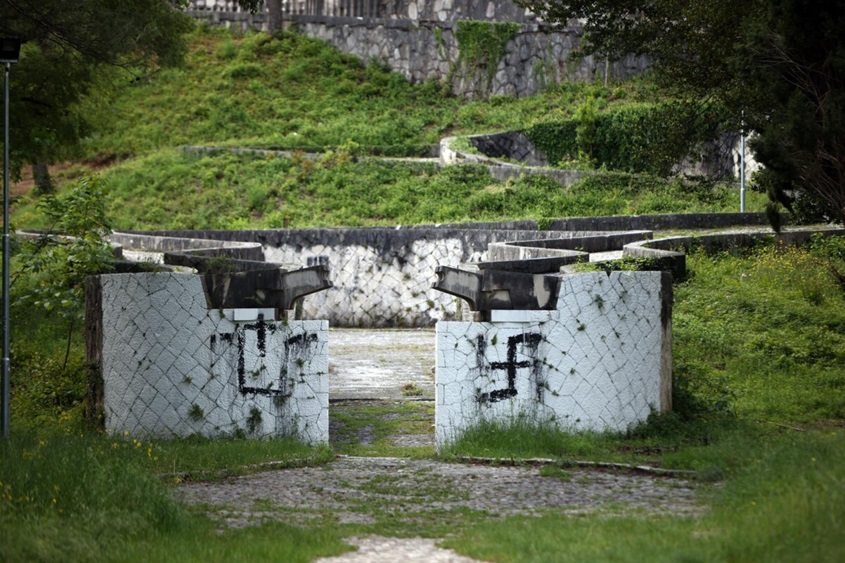All levels of authority in Bosnia and Herzegovina annually earmark USD 50 per capita for preservation of cultural and natural heritage. However, our cultural and natural heritage is largely devastated, privatized or threatened by the interests of private investors regardless of the millions of convertible marks intended for its preservation and protection. The reasons for this state of affairs should be sought in the maze of statutory jurisdictions and political interests.
Thanks to the initiative of UNESCO Institute for Statistics, the BiH Statistics Agency collected the data on allocations for cultural and natural heritage, and consolidated the information from the BiH Ministry of Finance and Treasury, the Federation Ministry of Finance and the RS Ministry of Finance.
According to the official data USD 51.15 per capita is earmarked on average in our country for preservation and protection of the cultural and natural heritage.
Bosnia and Herzegovina, according to the latest 2013 Census, has 3.531.159 citizens. By using a very simple math i.e. by multiplying the three-year average of USD 51.15 and the total number of citizens, we arrive at an incredible figure of more than USD 180 million annually.
“Total per capita expenditures for the preservation and protection of the entire cultural and natural heritage at all levels of authority in Bosnia and Herzegovina amounted to 51.59 PPP (constant 2017 USD) per capita in 2019, 49.55 PPP per capita in 2020, and 52.31 PPP per capita in 2021”, emphasized Ivona Bulić from the BiH Statistics Agency.
Photo: Klix.ba
The spokeswoman of the Ministry of Civil Affairs, Zorica Rulj, provides similar data, although expressed in Convertible Marks, and explains that we earmark almost this entire amount for the cultural heritage: “Total expenditures (public and private) per capita spent on cultural and natural heritage (for 2020) were BAM 50.47, whereof BAM 48.08 went on cultural heritage.”
She underlined that these allocations secure “financial, technical conditions for permanent maintenance of cultural and historic heritage and its integration into development flows at the local and regional level; integration of heritage into spatial and development plans i.e. establishment of a functional relation between the cultural-historical and natural heritage”.
Let’s us circle back to the initiative of the UNESCO Institute for Statistics. A manual of the UNESCO Institute was developed as part of this initiative and it represents a relevant methodology for consolidation of these data.
Thus, the total amount of USD 180 million includes the private and public expenditures for libraries and museum activities, as well as costs associated with conservation and protection of cultural and natural heritage. The statistics, in addition to the public expenditures, also includes investments by individuals and private organizations in this area.
Seeking answers to the question about how the funds are spent and on what, we contacted the FBiH Government and the RS Government, entity institutions – the Institute for the Protection of Monuments within the Federation Ministry of Culture and Sports, the RS Institute for the Protection of Cultural, Historical and Natural Heritage and Ministry of Education and Culture of the Republika Srpska.
The FBiH Government referred us to the Federation Bureau of Statistics, the Federation Ministry of Culture and Sports, the Federation Ministry of Spatial Planning, the Federation Ministry of Environment and Tourism, and the RS Government forwarded our inquiry to the Ministry of Education and Culture.
By the time the text was published, we received a response from the RS Institute for the Protection of Cultural, Historical and Natural Heritage:
“The RS Institute for the Protection of Cultural, Historical and Natural Heritage covers both the protection of natural heritage and the protection of cultural heritage, so it is impossible to provide the exact figures, because the projects mostly overlap, as do the areas in which they are implemented. As for the financial framework until 2023, the budget for program activities was BAM 100.000, while in 2023 it was increased to BAM 460.000, and the budget adopted is the same for 2024”, emphasized Jasna Milešević from the RS Government.
It seems that we also need a manual for monitoring the exact allocations by the competent institutions.
Perhaps we will wait for the UNESCO to prepare an initiative, but until then, the only thing left to do in the maze of jurisdictions is to investigate whom finds the non-existence of a single law suitable.
We are not competent
The protection of cultural and historical heritage in BiH is defined by a series of normative instruments and laws at different levels of authority. This area is legally regulated by entity legislation and legal acts of the Brčko District, as well as by the Decisions of the Commission for the Preservation of National Monuments.
We find a number of normative instruments in this formal and legal maze, such as the Convention for the Protection of World Cultural and Natural Heritage, the Convention for the Preservation of Intangible Cultural Heritage and the Convention on the Protection and Promotion of the Diversity of Cultural Expressions.
Although Bosnia and Herzegovina became a member of the United Nations Educational, Scientific and Cultural Organization (UNESCO) in 1993 and ratified the conventions, they usually remain dead letter without involvement of foreign donors.
One of the solutions of the Law on the Protection and Preservation of the Cultural and Historical Heritage of Bosnia and Herzegovina, which would lead to the harmonization of the legal framework with international standards, has been obstructed for years.
The Institute for the Protection of Monuments within the Federation Ministry of Culture and Sports and the RS Institute for the Protection of Cultural-Historical and Natural Heritage are entity institutions “responsible for the protection of heritage, which perform expert tasks related to the protection and the use of cultural-historical heritage, and supervise implementation of programs and projects for the protection and the use of heritage items”, said Inka Šehović from the Secretariat of the Commission for the Preservation of National Monuments.
Photo: Klix.ba/G.Š.
On the other hand, Šehović explained, the Federation Ministry of Culture and Sports “determines the criteria by virtue of which the Government of the Federation of Bosnia and Herzegovina makes decisions on the financing of protection projects”, the RS Ministry of Education and Culture “prepares programs and agreements on cooperation in the field of culture”, while both Ministries “perform tasks related to the protection and the use of cultural and historical heritage”.
There is also the cantonal level in FBiH, where five out of the ten cantons have established cantonal institutes for the protection of cultural and historical heritage located in Sarajevo, Bugojno, Tuzla, Mostar and Bihać.
“It is enough if I say that the legislation in this area was drafted for the entire Republika Srpska, while in the Federation of BiH it was split between ten cantons, and at the time of the analysis, two years ago, only five out of then cantons had adopted heritage-related laws, and there are frequent instances of 1985 Law being used. The only institution at the state level is the Commission for the Protection of National Monuments without any means to implement its own decisions,” said Mevlida Serdarević from the organization he Association for Intercultural Activities and the Rescue of the Cultural heritage, which has been working on drafting a new law in this area for the past three years.
We don’t want a national law, we want obstruction
In addition to the aforementioned initiative of the Association for Intercultural Activities and the Rescue of Heritage, which has been working on drafting new laws in this area for the last three years, there were some activities implemented from 2004 to 2010 concerning preparation of the draft Law on the Protection and Preservation of the Cultural and Historical Heritage of Bosnia and Herzegovina with the legal and political assistance of the Council of Europe.
The Commission for the Preservation of National Monuments, as the official proponent, coordinated the drafting of the Law, and the Ministry of Civil Affairs of Bosnia and Herzegovina in cooperation with the Federation Ministry of Culture and Sports and the Institute for the Protection of Monuments within this Ministry, the RS Ministry of Education and Culture the RS Institute for the Protection of the Cultural-Historical and Natural Heritage drafted the Law.
The draft Law on the Protection and Preservation of Cultural and Historical Heritage at the national level never entered the parliamentary procedure, nor was a comprehensive strategy for the management of monuments adopted. Zorica Rulj, spokeswoman for the Ministry of Civil Affairs, explained what actually led to the obstruction:
“The recommendations given to the Ministry of Civil Affairs are to ensure a thorough revision of the existing Draft Law on Cultural Heritage of BiH in line with international standards and to strengthen the protection framework, whereby the management will be still done through the Commission for the Preservation of National Monuments. Two acts were passed in Republika Srpska in 2008 that do not support the adoption of the Law on Cultural Goods of BiH.”
The aforementioned acts – the Opinion on the Draft Law on Cultural Goods and the Conclusion of the RS Government, obstructed the attainment of the cultural heritage protection goals at the national level and the establishment of an adequate legal framework for the protection of cultural heritage.
“The Commission for the Preservation of National Monuments is currently the only institution that has competence in this area at the national level”, noted Rulj and explained that “the Law on the Protection and Preservation of Cultural, Historical and Natural Heritage from 1985 represented continuity in legal protection of heritage since 1945 and was enforced until the beginning of the war in 1992 at the level of Bosnia and Herzegovina. Heritage was established as a public good and regardless of ownership (public or private) required public investment in protection and restoration works.”
Photo: Dejan Rakita/Pixsell
Abstention, conscience and awareness
In the search for jurisdiction, we have learned that the Commission for the Preservation of National Monuments only “decides on petitions to declare an asset as a national monument, and the entity on whose territory the asset is located is obliged to “make every effort to undertake appropriate legal, scientific, technical, administrative and financial measures necessary for the protection, conservation, presentation and restoration of the asset and to abstain from undertaking any intentional actions that could damage the asset”.
So, no matter how many new monuments the Commission for the Preservation of National Monuments declares, without entities’ response we don’t have any promise that such monuments will receive the necessary care and protection.
On the contrary, practice shows that a large number of existing monuments are endangered and that “abstaining from undertaking any intentional actions that could damage the asset” doesn’t sit well with the authorities, especially when investors have other interests.
“The manager, owners and other users of the national monument should treat the national monument conscientiously and with the due care”, explained Inka Šehović from the Secretariat of the Commission for the Preservation of National Monuments.
It is to be expected that the “conscience” of the citizens will not exist without awareness being raised about of the importance and potential of national monuments. Thus the result of our joint “abstention”, “conscience” and “awareness” is a list of eighty-seven national monuments that the Commission has characterized as “endangered”.
Historical building – Hajduk Tower on Kručevića Hill near Čitluk, FBiH, photo: Commission for the Preservation of National Monuments
Several reasons that testify to the attitude of our citizens towards national monuments were listed, such as the case of Resulbegović’s house in Trebinje, endangered due to the “concreting of the slab and the construction of sports fields in the area of the protected monument”. The historical area – the Necropolis with medieval tombstones on Ozren, endangered due to vandalism “relocation of tombstones in Travnjak location and motor vehicles driving over the tombstones in Bandijera location” and the Archaeological area – the Hellenistic city of Daorson in Ošanići near Stolac, which is covered with graffiti.
However, majority of the reasons are usually the same – illegal construction of new buildings within the protected zones, failure to undertake urgent measures to protect against further deterioration, undefined ownership structure or privatization, and fires, moisture and vegetation.
Often, when making decisions about “glazing the garden of a restaurant on Ferhadija Street” or demolishing “Topola” hotel, our authorities, responsible for management, become complicit in vandalism.
Nevertheless, our legislation foresees such situations, so the competent entity inspections, according to Šehović, “perform the tasks of inspection and supervision of protected areas where cultural and historical assets are located and are authorized to take statutory protection measures, including decisions suspending all interventions that are not in accordance with the law, i.e. restoring the assets to the state they were in before illegal or unprofessional interventions.”
As usual, inspections do “everything in accordance with the law”, so the mayor of Ilidža Municipality, Senaid Memić, illegally demolished hotel “Topola”, one of the oldest buildings in Canton Sarajevo, which was located in the protected natural area of Vrelo Bosne.
Although the former mayor claims that Ilidža Municipality Inspection Service “did everything in accordance with the law”, the Institute for the Protection of Cultural-Historical and Natural Heritage of Sarajevo Canton confirmed that it was an illegal demolition.
As a result, the Regulatory Plan of the Spa and Recreational Complex, which provided for the preservation of this hotel complex and protection measures, failed and Sarajevo became poorer for an important cultural monument and lost the opportunity to reconstruct the hotel with the aim of restoring the original architectural expression.
Similar examples of management and protection of cultural and historical heritage can be seen in the example of the situation in Počitelj, as well as the situation in Višegrad.
A blatant example – Počitelj
“Počitelj today is an important tourist destination in our country, but it is neglected, overgrown with vegetation, without street lighting, without garbage collection and with landfills. Počitelj is without access to the river and without access to the public toilet, which has been reconstructed, but is prohibited. A city that is not maintained is deteriorating, and this is visible at every step,” pointed out Jadranka Dizdar, president of the Počitelj Tourist Association.
Danijela Nogolica, spokeswoman for the City Administration of the city of Čapljina, sees the problem in the jurisdiction of several institutions (three Federation ministries and the Commission for the Preservation of National Monuments), and emphasizes that the City Administration is doing everything to alleviate this problem and is advocating for “the competences for Počitelj to be handed over to the Local Community that knows the problem best”.
Nogolica also points out that the City Administration has found significant funds and started addressing critical areas – the roof of the Gavrankapetanović’s Tower was renovated, and the main project for the architectural lighting of the tower was created.
She also mentioned that the preparation of the project “Development of project and technical documentation for the constructive rehabilitation of the Gavrankapetanović’s tower and the surrounding walls of the protected zone” is underway.
Počitelj was included on the List of the Most Endangered Monuments in 1996 and 1998, while the Town Hall and Mehmed Paša Sokolović Bridge in Višegrad were also included on the List in 2008.
Although the process took a long time, the Town Hall and the Bridge were restored, and the initiative for reconstruction in Počitelj followed in 2003 and 2004 as to start reconstructing the “destroyed, devastated and looted city using the funds provided by the Fund of the Federation of Bosnia and Herzegovina”, emphasized Dizdar, adding that on that occasion “the mosque, the art colony, the gate, the hammam, a portion of the houses, the alleys were renovated, and the fortresses, water supply and sewerage in the upper part of the city were built a little later”.
Photo: Klix.ba
However, these individual steps without coordination between competent institutions do not allow restoration of Počitelj’s former glory. Buildings that have been there for centuries are falling apart, just like one of the most beautiful buildings of the madrasa – the hammam. Dizdar points out that 1993 was a disastrous year for Počitelj, because the law on privatization was passed then, and was also applied to the cultural and historical monuments of the old town of Počitelj.
“In order to restore Počitelji’s former glory and to have it functioning as a tourist destination in the truest sense of the word, it is first of all necessary to clear up proprietary and legal relations, which entails the nationalization of cultural and historical monuments”, noted Dizdar and pointed out that it is necessary to revise the privatization because, in her opinion, the buildings in Počitelj that at the time of their construction had a social purpose (such as a tower, fortress, hammam) were “illegal appropriated”.
Portal Tačno.net wrote about the process of privatization of property in Počitelj seven years ago in the text Joint criminal enterprise in Počitelj. Most of the buildings of cultural and historical significance in Počitelj belonged to the Islamic community and natural persons, who gave it to this religious organization for management through the institution of waqf.
In the nationalization process the management of properties is taken over by the state enterprise Ugostiteljstvo i Turizam (hospitality and tourism) Čapljina (UIT), which, in addition to the facilities in Počitelj, also owned other tourist facilities such as Hotel Mogorjelo, City coffee shop, Elita, as well as a number of other properties. In the period after the war, due to a series of deliberately made legal omissions, numerous buildings, specifically in Počitelj, that were actually owned by natural persons and the Islamic community, were registered as the property of the UIT.
The privatization process begins after the property in Počitelj was registered to the company Hospitality and tourism. Privatization was carried out in 2001 using the model of public offering of shares, and the total capital at that time was 100% state-owned and amounted to BAM 1.054.734. Capital was purchased by 15 natural persons, and the majority owner of the capital is Hasan Valedar.
Hasan Veledar had in 2009 bought from UIT 27 properties in Počitelj and 6.000 m2 of land and a reservoir for the water supply of the citizens of Počitelj for the amount of approx. 300 thousand convertible marks. The funds were never paid into the account of UIT, considering that, as the contract emphasized, it was a question of compensation of debts that this company had towards its majority owner, Veledar.
Unfortunately, nothing has been done to date regarding the revitalization of Počitelj as one of the most significant tourist potentials of Herzegovina.
If only we were a little further west
The potential of our rich cultural heritage in the context of tourism was presented last year by the Commission for the Preservation of National Monuments on the occasion of the International Day of Monuments and Sites. The importance of issues of restoration, reconstruction and revitalization and their central role in sustainable tourism was highlighted, as well as the fact that the development of cultural tourism protects cultural heritage.
For example, Italy and its historical monuments, museums and works of art attract millions of visitors, so the tourism sector makes up 14% of the country’s GDP and employs 1.5 million people. National monuments in Italy are managed by the ministries for cultural heritage and activities in tourism, regional or local authorities, but also private organizations and foundations dedicated to the preservation of cultural heritage – similar, yet diametrically opposed to Bosnia and Herzegovina.











